
Who invented snakes and ladders
I bet you must have played this game at least once in your lifetime? Didn’t you? I don’t know about the western world or countries outside India, but what I know for sure is that this game is played in every nook and corner of India. Every Indian must have played this game at least once in his childhood days. But as an Indian, did you ever thought on why this game was invented or who invented this game or from where did this game originates? From my experience, I can say very few of us must have thought about it in our school days. We were always bothered in winning the game ahead of all our friends and were never bothered on who invented this game or why this game was invented?
In early adolescence, when I got to know the motive behind the game, I found it very interesting and I thought to share it with you since it explains a good spiritual side of our life. Before that, let us see some details about the origin of this game
Who invented snakes and ladders?
Regarded worldwide today as a classic game, Snake and ladder was invented in India. Though the exact date and place is not known, Government of India credits the invention of this game to poet cum spiritual guru ‘Gyandev’, also known as Jnanashwar, of the 13th century AD. Conversely, according to latest archeological evidences, this game existed in 2nd century BC. Originally called as Mokshapath or Moksha-Patamu(Path to salvation), this game was transported to western world by British rulers in 1892. They called it snakes and ladders, the name I find less fascinating compared to Mokshapath(Path to salvation). They also stripped off the moral and religious values of this game thus making it even less fascinating. In Sanskrit, this game was also known as 'Parama Pada Sopana Patam', meaning the chart showing the ladder that leads to the ultimate state
Mokshapath- original snake and ladder game
Originally, Mokshapath had 132 blocks with a different picture in each square. Each square represented a human quality or a living creature. Human quality meant that you have achieved that quality as per your deeds while a living creature meant that you have become that creature because of your deeds.

Vaikuntha palli- a variation to mokshapath
For example, block 8 represents a frog which means that you did bad deeds which made you a frog in your next life. Block 51 represents horse which means you got the power of agility and quickness. Similarly each block had a particular meaning associated with it. Once the player reaches the last block, he has to wait for the right number to fall to win the game.
Mokshapath is more interesting than current snakes and ladders
Doesn’t it sound more interesting than the westernized snake and ladder game we played in our childhood days? Sadly, I don’t find a single shop where I can get the original mokshapat game, courtesy of the destruction done on Indian culture by the British rule. If I had a big resort or something, than I would have created such a game in my lawn and I am damn sure that all visitors to the resort would have yearned to play their childhood game in a new interesting avatar once again.
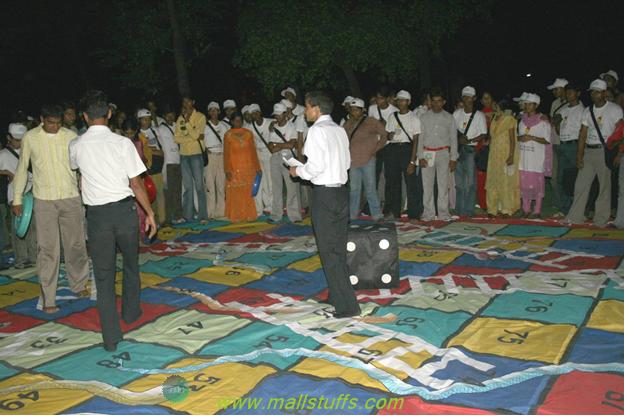
Snake and ladder game played publicly
Spiritual meaning of Mokshapath
Traditionally, this game was invented by Jnaneshwar as a moral lesson to young kids. In the original game, Ladder symbolized virtues (Good karma) such as faith, generosity and humility while snakes symbolized vices (Bad Karma) such as anger, lust, murder, and theft. Combination of several good deeds (ladders) will take you to heaven while a single bad deed (Snake) is enough to take you to hell.

Variation of Mokshapath
This game teaches us that we do many good and bad deeds in our life and accordingly, we move up and down towards our ultimate goal (Materialistic or spiritual). i.e. this game teaches the law of karma. This game was used not only for entertainment but also to teach children’s on what they should do and what they shouldn’t in their future life. These dos/Don’ts results in divine punishment or reward, ethical values, morality and determines the character of an individual.
Mokshapath depicts the laws of karma and reincarnation
This game also explains the Hinduism concept of reincarnation. This game says ultimate goal of life is ‘Moksha’. Each block in this game represents a house. Snake bite means you do bad karma and soul is reborn as lower life forms (dog, chicken, frog etc) while ladder means you do good karma and soul is reborn in a wealthy prosperous family. This cycle of life and death repeats till the soul is liberated (Moksha)
Original game was all about karma and destiny. In the original game, each ladder was represented by a good human quality while each snake was represented by a bad quality. Depending upon the quality one attains to, he ascends or descends in the game. For EX: The snake at hinsa (Violence), a very bad quality, will take you down to block of mahanarak (Great hell) while ladder at Vidyabhyas (education), a very good quality, will take you up to block of Shastras (knowledge). Similarly, a ladder at Asceticism will take you to god (kailasha of Lord shiva), (vaikuntha of Lord Vishnu), (brahmaloka of Lord brahma) while a ladder at murder will take you to hell.
Whenever the person does a good deed, he ends up in the house having bottom of ladder and is promoted upwards more closer to god in the path of attaining salvation
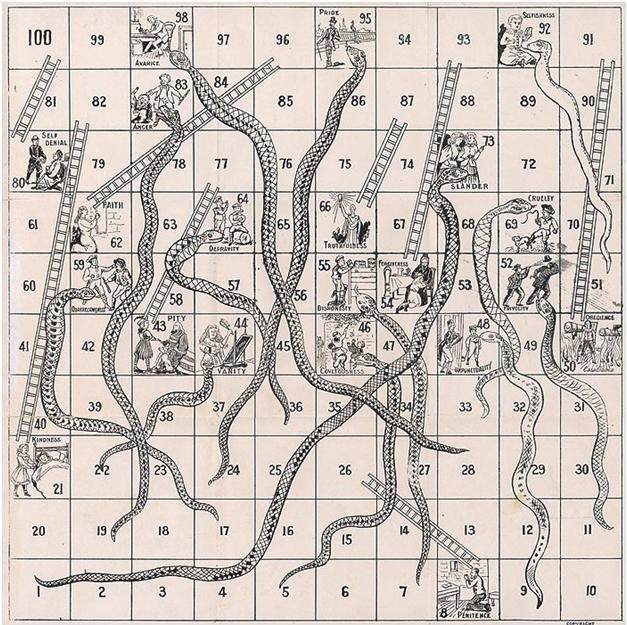
A slightly different version used in Australia
Number of ladders and snakes in Mokshapath
Originally, snakes (Evil deeds) outnumbered the ladders (Good deeds) which is the usual case with all humans. Humans are more attracted to bad deeds in search of materialistic pleasures instead of good deeds in search of Moksha (salvation). It also means following a good path is very tough compared to following a sinful path.
Various good qualities (Ladders) in the original game were
12 - Faith
51 - Reliability
57 - Generosity
76 - Knowledge
78 - Asceticism.
Various bad qualities (snakes) in the original game were
41 - Disobedience
44 - Arrogance
49 - Vulgarity
52 - Theft
58 - Lying
62 - Drunkenness
69 - Debt
73 - Murder
84 - Anger
92 - Greed
95 - Pride
99 - Lust
100 was the square of Nirvana or Moksha. Player has to reach this block to win the game
Mokshapat in south India
A different version of this game existed in south Indian culture where it was called as ‘Vaikuntapalli’ or ‘Paramapada Sopanam’. Along with moral values, this game was intended to develop skills and quick thinking in the child mind. In this variation, two players compete on the board and collect coins, shells or seeds. Player which collects the maximum number of coins becomes the winner. There were nine more variations to this game according to regional, religious and caste differences. These games were very popular among Indian women’s since they had to stay indoors or closed areas for majority of their time.
A short mention of dices in Indian culture
This game was played using a dice. Tradition of using dices in games is very old in Indian culture, references of which are found in rig veda and Mahabharata. In fact, the deadliest war of all times ‘Mahabharata war’ which killed more than 6 million lives happened because of dice. Earliest excavated dices were found in the harrapan sites which are supposed to be of the Mahabharata era.
Mention of snakes and ladder meaning in salman rushdie book
Salman rushdie, Indian born writer, in his book “Midnight's Children described the moral of this game as follows
“All games have morals; and the game of Snakes and Ladders captures, as no other activity can hope to do, the eternal truth that for every ladder you hope to climb, a snake is waiting just around the corner, and for every snake a ladder will compensate. But it's more than that; no mere carrot-and-stick affair; because implicit in the game is unchanging twoness of things, the duality of up against down, good against evil; the solid rationality of ladders balances the occult sinuosities of the serpent; in the opposition of staircase and cobra we can see, metaphorically, all conceivable oppositions, Alpha against Omega, father against mother.”
Western Variations of this game
The first variation of moskhapat was done by the British rulers ruling India when they transported this game in Europe as snakes and ladder in 1892. The most common version of Snakes and Ladders in Britain is the Spear's Games version.
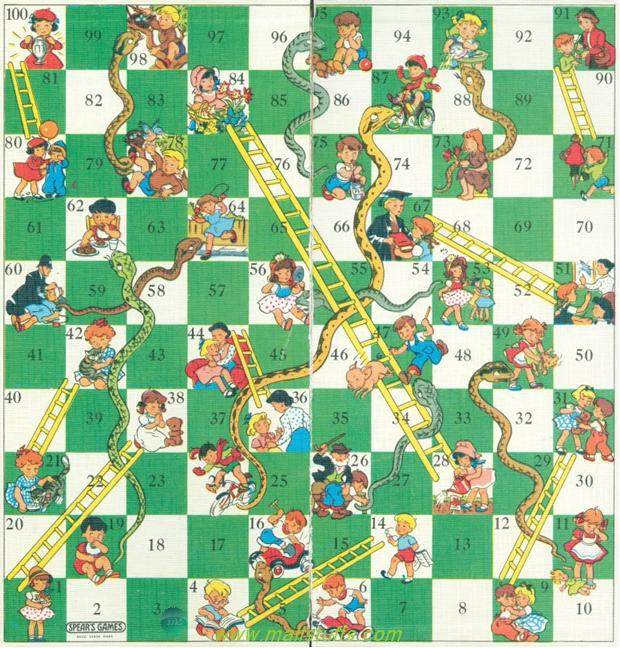
British Spear game version of snakes and ladders
US Chutes and ladders
This game reached United States in 1943, where it was called as Chutes and Ladders by Milton Bradley. In US, current chutes and ladder game is played using a spinner instead of a die. Moreover, for some block, other players award the player with a candy or similar such incentives.
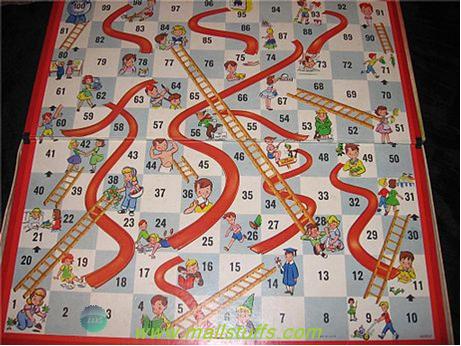
American Chutes and ladders
According to an American survey, a player needs and average of 39.6 spins to move to square 100 from the starting point. Oh god, Americans do survey on everything :)
Eric Edelman, a collagist, writer and sculptor based in New York City, created a slightly different version where he showed the snake and ladder game as a chakravyuh(Circle of birth and death). A person reaching at the centre of the board wins the game. Same like, the person who enlightens the Soul situated in the centre of the body to attain salvation. His works is very popular and are usually displayed in private museums, private galleries and institutional collections.
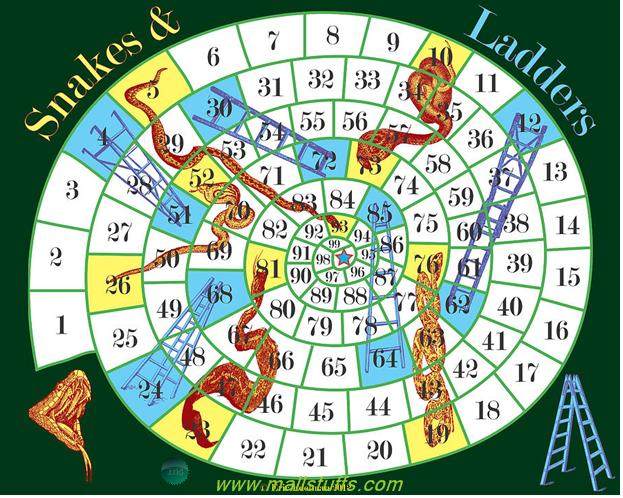 Eric Edelman snakes and ladder
Eric Edelman snakes and ladder
This game was introduced in Canada by Canada Games Company. After the demise of Canada Games Company, Chutes and Ladders produced by Milton Bradley/Hasbro became popular in Canada.
In recent years, this game has been released in form of various popular television cartoons like "Dora-The Explorer" and "SpongeBob Square Pants"
In April 2011, Yazino introduced the first online, real-time, multiplayer game where you compete against your friends to win game and some money.
In western world, this game is usually played in homemade constructed board where the players themselves stands on the board and throws a dice to move across the board. Interesting! Isn’t it?
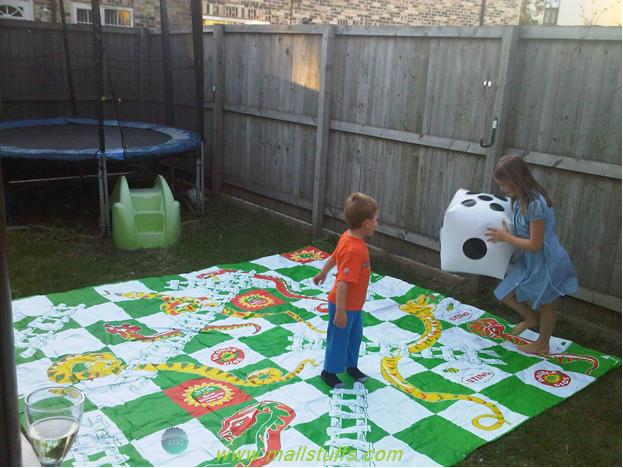
Big homemade constructed snakes and ladders
Conclusion:
Today, many variations of mokshapath are copyrighted by private companies. It just makes me wonder if India would have copyrighted this game than the whole world would have been paying royalty to India. If India would have copyrighted mathematics than today, no doubt, India would have been the richest economy of the world. Why it didn’t happen? Well, Indian seers never desired materialistic pleasures. Their goal was only Salvation (Moksha) and preaching of good moral values in society. They did all their invention for gods and betterment of the society. Still, many Indians have forgotten their culture and in their endeavor of attaining all modern comforts and pleasures are gradually following the westernized world, discarding their ancient rich cultural heritage and true purpose of life. Hope, we realizes the importance of our cultural values and the good times comes again!
Note: Images used on this website
are either a production of Bhaktivedanta Book Trust(https://www.krishna.com), Iskcon
Foundation or were found in google search under "Free to use and share". If any
of the images presented here violates copyright issues or infringes anyone copyright
or are not under "Fair use", then please bring it to our notice. Read
Disclaimer for more.
Share this to your friends. One of your friend is
waiting for your share.
Related Articles
Living in an illusionist world-Part 1
Is lord ganesha God and worthy of worship
Swastika-Most sacred symbol of all ancient civilization
Hinduism greatness quotes by famous philosophers and scientists
Science in Hinduism-Large numbers and infinity
Hindu mantras for wealth and abundance
Why number 108 is holy and auspicious in Hinduism
Living in an illusionist world-Part 2
Chanakya Arthashastra-Greatest book on spying and secret agenies
Why lord Ganesha have elephant head
Post Comment